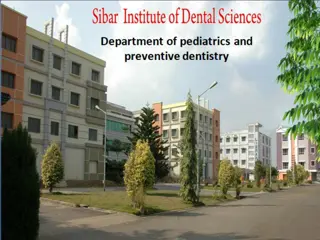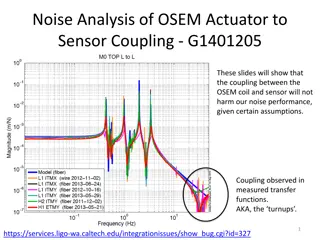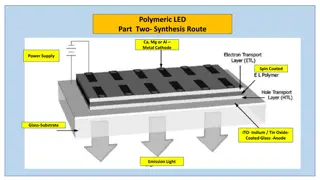Understanding Polymeric Prodrug Coupling Methods
Coupling methods in polymeric prodrugs involves the conjugation of drugs or biomolecules with polymers through stable bond linkages like ester, amide, or disulfide bonds. Different coupling agents and reactive groups are utilized to achieve successful conjugation, with recent advancements focusing on the use of homobifunctional and heterobifunctional coupling reagents for improved bioconjugation strategies.
Download Presentation

Please find below an Image/Link to download the presentation.
The content on the website is provided AS IS for your information and personal use only. It may not be sold, licensed, or shared on other websites without obtaining consent from the author. Download presentation by click this link. If you encounter any issues during the download, it is possible that the publisher has removed the file from their server.
E N D
Presentation Transcript
Coupling methods: Coupling reactions involves conjugation of drugs or other biocomponents with polymers. In coupling reactions, the reactive functional groups on the different cross-linking and the functional groups present on the target biomolecule are to be modified. Coupling agents mediate the conjugation of the two molecules by forming a bond with no additional spacer atom.
In case, the drug or the polymer contains more than one functional group, then the synthetic methodology to form a conjugate involves either protection or deprotection of the groups. The most commonly used strategies for coupling the components of polymeric prodrug involve use of coupling agents such as (DCC) and 1-ethyl-3-(3- dimethylaminopropyl) carbodiimide (EDC, EDCI) or use of N-hydroxysuccinimide esters.
Drugs or other biomolecules are chemically conjugated to polymers through ester, amide or disulfide bonds. The resulting bond linkage should be relatively stable to prevent drug release during its transport before the cellular localization of the drug .
Most of the bioconjugation strategies involve coupling reactive nucleophiles with the following order of reactivity: thiol, -amino groups, carboxyl and hydroxyl . The pH in the reaction and presence of steric hindrance on the coupling moiety controls this order of reactivity.
Recent advancements in coupling methods involve use of homobifunctional amine or heterobifunctional coupling reagents. A number of electrophilic groups e.g. epoxides, vinylsulphones, and aziridines are capable of reacting with amines and other nucleophiles.
1-Homobifunctional compounds such as: N,N -ethyleneiminoyl- 1-6-diaminohexane, bis-aziridin, divinyl sulphone(DVS), nitrogen mustard and bis-sulphonyl chloride can form protein protein linkages while 2-heterobifunctional reagents are useful to couple amines with other functional groups. Reactive groups in proteincarboxyl functions offer alternating thiol reactions as a site for hetero bifunctional coupling with amines .
NHS shows higher reactivity at physiological pH, therefore it is used for amine coupling reactions in bioconjugation synthesis. * NHS ester cpds react with Nu.s to form an acylated product with NHS as a leaving group. Carboxyl groups activated with NHS esters are highly reactive with amine nucleophiles. Carboxyl groups are easily reacted with amine nucleophiles after their activation by NHS esters.
*DCC It is mainly used to couple amino acids during artificial peptide synthesis. It is highly soluble in DCM, THF,acetonitrile and DMF. A range of alcohols, including even some tertiary alcohols, can be esterified using a carboxylic acid in the presence of DCC and a catalytic amount of DMAP (Dimethyl amino pyridine) .
(EDC, EDCI) It is mainly used as a carboxyl activating agent for the coupling of primary amines to yield amide bonds. EDC is often used in combination with N- hydroxysuccinimide (NHS) or sulfo-NHS to increase coupling efficiency or create a stable amine-reactive product. EDC is also used to couple a carboxylic acid to alcohol using DMAP as a catalyst
EDC can also be used to activate phosphate groups. Biomacromolecules containing phosphate grps such as the 5 -phosphate of oligonucleotide can be conjugated to amine containing molecules by using EDC. EDC activates the phosphate to an intermediate phosphate ester. Further, in the presence of an amine carbodiimide can be conjugated to form a stable phosphoramidate bond.
HOBt is used for the synthesis of amides from carboxylic acids from amino acids .
Coupling of hydroxyl group containing polymers to alcohols and amines: Polymers containing - OH groups (e.g. PEG) can be modified to Carboxylic acid derivative by treating with acid anhydrides.
PEG can be acetylated with anhydrides (e.g. succinic anhydride) to form an ester terminating to free carboxylate groups. The resulting succinylated derivative containing free -COOH group can be further used for conjugation with drugs or proteins (Figure 8). The succinyl group incorporated in the polymer may act as spacer between the polymer and the drug which may control the site and the rate of release of the active drug from the conjugate by hydrolytic or enzymatic cleavage.
Coupling of drug and polymer through spacer: Spacers may be incorporated during bioconjugation to decrease the crowding effect and steric hindrance and control the site and the rate of release of the active drug from the conjugate. Spacers can enhance ligandprotein binding and has application in prodrug conjugates and in biotechnology. Amino acid such as glycine, alanine, and small peptides are widely used as spacers due to their chemical versatility for covalent conjugation and biodegradability . applications in biotechnology
The -amino acids in peptides and proteins (excluding proline) consist of a carboxylic acid (-COOH)and an amino (-NH2) functional group attached to the same tetrahedral carbon atom which extends diversity for conjugation with hydroxyl,carboxyl or amino groups of polymer or biomolecule. Moreover, amino acid based spacers are short-chained, reactive, and biocompatible and may release the active agent from the conjugate. Di-functional amino acids such as 6- amino caproic acid (6-ACA) or 4 amino butyric acids (4 ABA) have been used as spacer arms between the polymers and the ligands for applications in biotechnology.
A polymeric prodrug of alkylating agent mitomycin C (MMC) with poly[N5-(2-hydroxyethyl)-L- glutamine] (PHEG) using oligopeptide spacers was designed predominantly for enzymatic degradation which released MMC with a rate dependant manner (Figure 9)
Heterobifunctional coupling agents containing succinimidyl group have also been used extensively as spacers.























